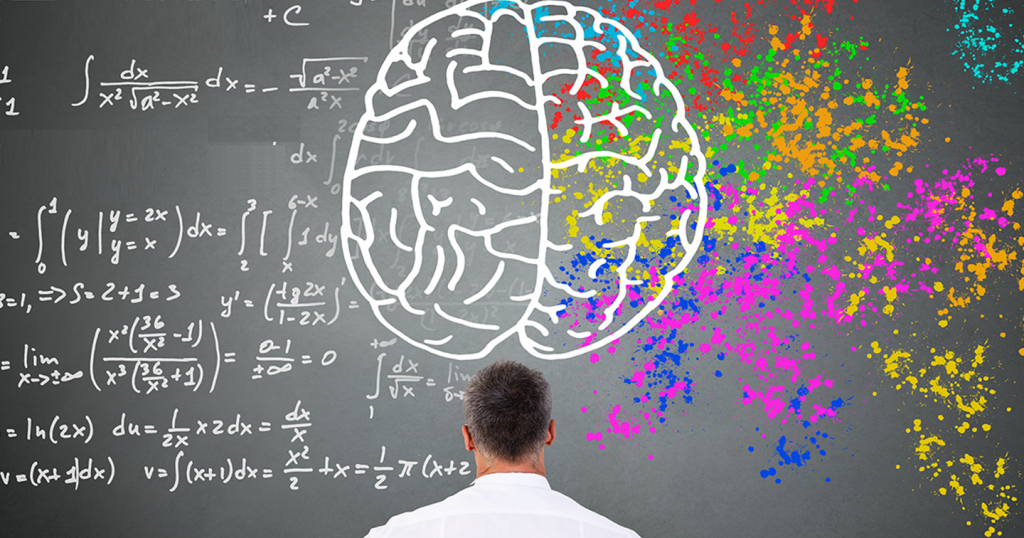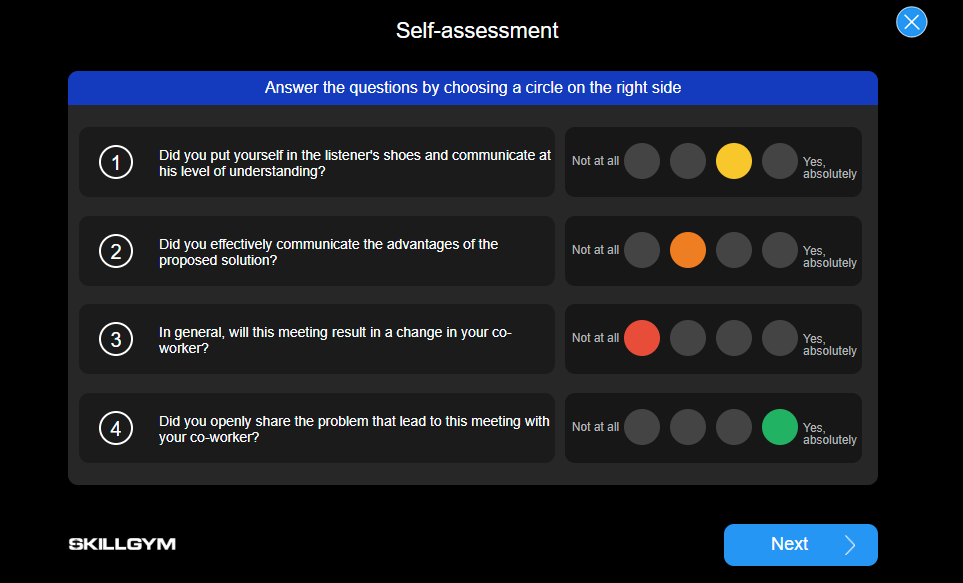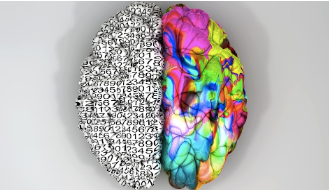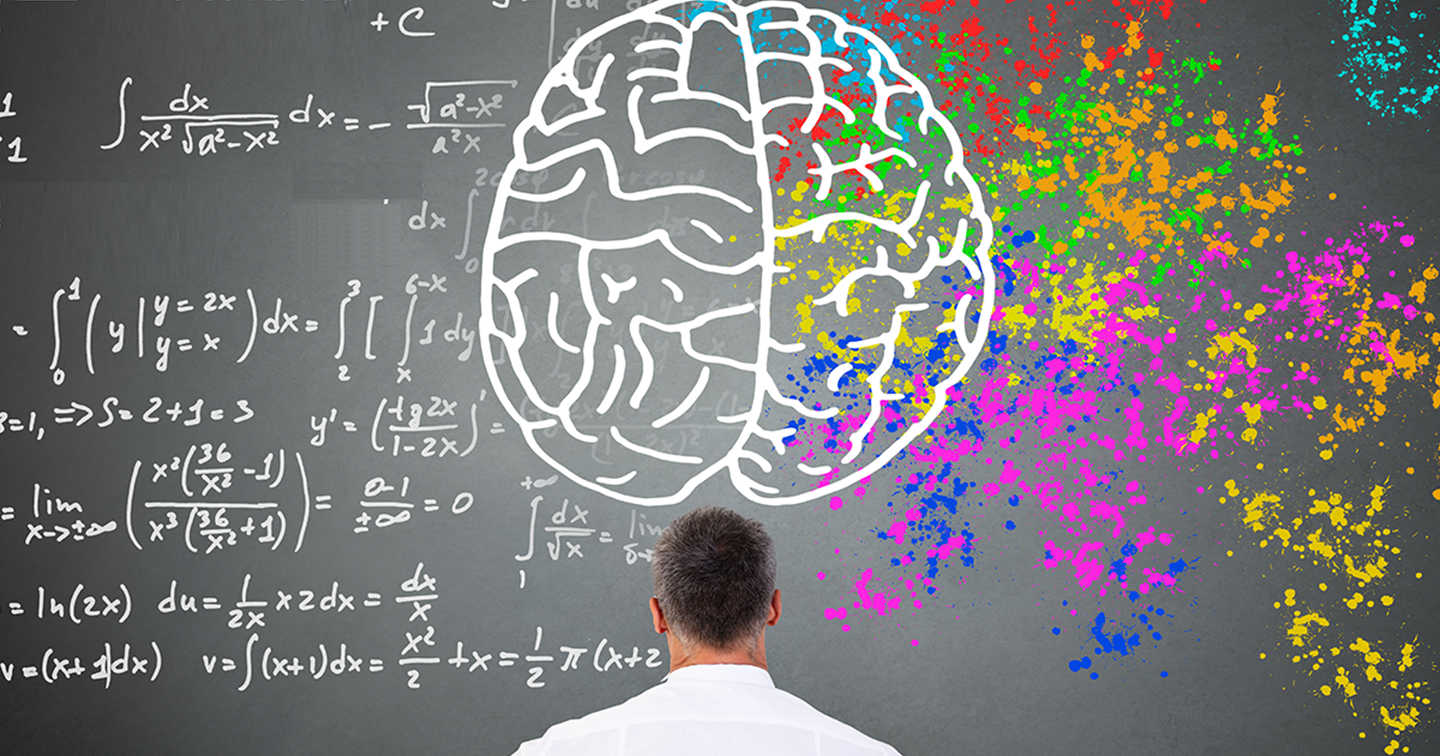
During training, it is harder to improve your performance if you are not aware of your real level of expertise from the very beginning. That’s why this first step is crucial at the beginning of a training.
There are different ways to raise self-awareness: the emotional feedback and the concrete figures. Here we will show you that mixing the two is even more efficient.
Your vision will become clear only when you can look into your own heart. Who looks outside, dreams; who looks inside, awakes. – Carl Jung
Self-awareness: an important asset
First, let’s define what self-awareness is. It means that you have a clear and honest vision of your personality that includes not only strengths and weaknesses, but also your emotions and motivations.
In other words, it is the ability to know what you are doing as you do it and understand why you are doing it. Self-awareness is a skill, and like all skills, it needs to be trained.
Being self-aware of your own performance is key. Here are a few reasons:
- When you’re aware of your weaknesses, it’s easier for you to define which way to direct your effort. You know what you have to improve and can directly focus on it.
- It’s also easier to rely on others who don’t share your weaknesses in order to overcome difficulties. Working with complementary people is always easier when you already know what your strengths and weaknesses are.
- By being self-aware of your strengths and weaknesses, you gain objectivity and it helps you make all your choices and decisions.
- Self-awareness helps you be proactive instead of just reactive and makes you raise your standards to always aim at doing better. In other words, it makes you respond rather than just react.
- Self-awareness helps you to improve your emotional intelligence, according to Daniel Goleman’s studies. And mastering this skill makes you understand better the problems you face and so the best ways to solve them.
For all these reasons, it is essential to stimulate self-awareness during training: if you know what your weaknesses are, it’s easier to work on the problem.
Besides, the more self-aware you are, the more rapid and efficient the training will be.
Self-awareness helps you be proactive instead of just reactive and makes you raise your standards to always aim at doing better.
How to efficiently stimulate self-awareness in the long term
In order to stimulate self-awareness, there are two consecutive steps: ask yourself good questions and get a feedback on your actions.
Once you’ve defined your motivations and goals, it’s easier to make decisions.
You can ask yourself for example:
- What am I trying to achieve?
- What am I doing that is working?
- What am I doing that is slowing me down?
- What can I do to change?

After your actions, you can ask for feedback from friends, colleagues or managers. We always need an objective, constructive and direct view on what we did, and they will play the role of the honest mirror for your actions and behaviors.
Feedback, whether it’s positive or negative, is the most powerful way to realize the impact of your actions and attitudes towards others.
But usually people are reluctant to give feedback freely, hence why you often have to ask for it specifically. In part because it’s not always easy or pleasant to hear (who likes to hear that he is performing poorly?); in part because managers, friends and colleagues don’t always have or take time to do it.
That’s why training via role plays using familiar conversations that learners face in their everyday life is a good alternative. It makes users self-aware of how they interact with people and what their impact on them is.
Getting feedback on the conversation they had during training maximizes the self-awareness effect while also helping them find a way to improve their performance.
The self-assessment role in self-awareness
Before getting a feedback from someone to know how you really performed during the role play, it’s very interesting and instructive to self-assess your actions and behaviors.
The questions you can ask yourself can be classified in two types: internal and external self-awareness.
Internal self-awareness is the way you evaluate the impact of your actions.
External self-awareness is having a clear view of what people think of you.
To go deeper into this subject, do not hesitate to read our article (“Self-Awareness: the Single Factor Influencing the Most the Speed of Leadership Development”).
After or during a simulated conversation, we assess internal self-awareness, for example, by asking you to evaluate:
- how the meeting went/is going
- how you think you interacted with your friend or colleague
- if you think he/she understood your point and arguments
- if and how you put into practice some skills, etc.
These questions seem ridiculously simple and you may think the answers are obvious, but this “inner examination” is the best way to raise your self-awareness of your performance because:
- You HAVE TO think objectively about your performance and the way you managed the conversation, but also about how the character perceived your approach. This is something we usually don’t do as part of our day-to-day activities.
- It will make you put into practice during subsequent conversations all the elements that you became aware of during this role play.
- In a more general way, assessing your own performance during the role play you’ve just done involves and engages you even more in the training, empowering you in the development of your performance.

SkillGym self-assessment questionnaire
Assessing your own performance during the role play you’ve just done involves and engages you even more in the training, empowering you in the development of your performance.
From self-assessment to feedback
Once you have self-assessed your performance, it’s time for you to receive feedback on what you did. There are two forms of feedback: subjective and objective.
Subjective feedback is usually an oral report from your counterpart, trainer or manager. It is defined as subjective because you receive his personal opinion on what you did.
He gives you his feelings, his perception and so this feedback depends on his characteristics, motivations, needs met, etc.
By receiving this feedback, you activate the right side of your brain, which is connected to feelings, imagination and holistic thinking, according to Roger W. Sperry’s right brain-left brain theory.
On another hand, the objective feedback consists within a set of metrics and measurable data and figures that provide information about your performance.
This can be, for example, a customer feedback survey, software results obtained after a training, etc.
By receiving this kind of feedback, you activate the left side of your brain, connected to logic, facts and analytical thinking.

What your brain hemispheres prefer
That’s why receiving both kinds of feedback is twice as efficient. You activate both sides of the brain and, by doing so, have a full vision of your performance as it raises your awareness of your true skill level.
Combine emotional feedback and analytical metrics: the Digital Role Play solution
As we said earlier, self-awareness is a skill and, like all skills, it needs to be regularly trained to improve.
Additionally, skills can improve or worsen over time as your strengths, weaknesses, motivations and goals evolve with your experience. That’s why regular practice helps you maintain it.
In order to put this skill into practice, it is shown that Digital Role Plays like SkillGym are very efficient. As it places the learners in real conditions of a familiar situation, it helps them see if they have the appropriate qualities, skills and behaviors for the task.
And in order to change them, repeated practice is the best way, as demonstrated in our article (“Why Use Interactive Storytelling in Training: Benefits of Role Plays”) on mirror neurons. Mirror neurons record what you see, hear and learn and thus help you unconsciously assimilate, repeat and improve your actions and behaviors.
The self-awareness skill can improve or worsen over time, as your strengths, weaknesses, motivations and goals evolve with your experience. That’s why regular practice helps you maintain it.
And thanks to digital technology, combining metrics and emotions has never been easier.
In SkillGym simulators:
- You can simulate in a safe environment one of the typical conversations you have with your teammates and managers by meeting a real character with his own needs, personality and moods.
- Then, after the meeting, you will be asked to assess your performance based on different questions on your behaviors, skills, approach, etc.
- You will receive an emotional feedback from the teammate or the manager you’ve just talked with. He will give his personal opinion on your approach and attitude during the meeting.
- Finally, you will be provided objective results and metrics in order to know exactly what your performance was: global performance, objectives reached, skills and behaviors, etc. Even your self-awareness is calculated according to your self-assessment.

The character’s feedback is always combined with objective metrics to give you a full overview of your approach
Using this unique approach, SkillGym is able to provide enough data for both your left and right hemispheres to process thus helping you raise your self-awareness on your strengths and weaknesses.
By knowing yourself better, you can focus on improving!
Conclusion
In adult learning, self-awareness is key.
Knowing what your skills and motivations are helps you focus on what the problems are, what you have to improve on and how you can do it.
To raise your self-awareness on your skills and improve them, SkillGym and its Digital Role Plays are the solution.
In a safe training environment, you can face as many simulated scenarios as you want, self-assess your performance, receive emotional feedback and evaluate your results thanks to objective metrics.
Do you want to go more in depth into the SkillGym approach? Don’t hesitate to read our article (“How AI Helps Delivering a Better SkillGym Training Experience”).
If you’re interested in the theories behind our approach, then why not read this article “Learning Theories Supporting SkillGym Methodology”?
If you are interested in our work and approach, book a 1-hour discovery call here.





